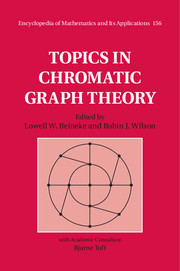Book contents
- Frontmatter
- Contents
- Foreword
- Preface
- Preliminaries
- 1 Colouring graphs on surfaces
- 2 Brooks's theorem
- 3 Chromatic polynomials
- 4 Hadwiger's conjecture
- 5 Edge-colourings
- 6 List-colourings
- 7 Perfect graphs
- 8 Geometric graphs
- 9 Integer flows and orientations
- 10 Colouring random graphs
- 11 Hypergraph colouring
- 12 Chromatic scheduling
- 13 Graph colouring algorithms
- 14 Colouring games
- 15 Unsolved graph colouring problems
- Notes on contributors
- Index
- References
1 - Colouring graphs on surfaces
Published online by Cambridge University Press: 05 May 2015
- Frontmatter
- Contents
- Foreword
- Preface
- Preliminaries
- 1 Colouring graphs on surfaces
- 2 Brooks's theorem
- 3 Chromatic polynomials
- 4 Hadwiger's conjecture
- 5 Edge-colourings
- 6 List-colourings
- 7 Perfect graphs
- 8 Geometric graphs
- 9 Integer flows and orientations
- 10 Colouring random graphs
- 11 Hypergraph colouring
- 12 Chromatic scheduling
- 13 Graph colouring algorithms
- 14 Colouring games
- 15 Unsolved graph colouring problems
- Notes on contributors
- Index
- References
Summary
Developments in graph colouring theory were motivated by the four-colour problem and Heawood's theorem. Both of these were originally formulated as map-colouring problems that can be expressed as colouring graphs embedded on surfaces. This chapter gives an overview of the abundance of results concerning the chromatic number of graphs that are embedded on surfaces.
Introduction
In 1852 Francis Guthrie asked whether the regions of every planar map can be coloured with four colours in such a way that no two regions of the map with common boundary receive the same colour. In effect, by duality Guthrie was asking whether every planar graph is 4-colourable. This easily stated problem became known as the famous four-colour problem. Attempts to solve it led to many important results in graph theory, but the problem itself remained unsolved for more than a century. It was finally answered in the positive by Appel and Haken [9], [10], [12]. More about its proof comes later in this chapter.
For more than a century, the four-colour problem was one of the driving forces that led to developments in graph theory, and specifically graph colouring theory. Its generalization – the Heawood problem – was the main motivation for developments in topological graph theory (see [51] or [49]). Both of these were originally formulated as map-colouring problems, asking about colouring the faces of an embedded graph so that adjacent faces receive different colours. Every map-colouring problem can be expressed as a graph-colouring problem by considering the dual graph of the map. Its vertices correspond to the faces of the map, and two vertices are adjacent if the corresponding faces are adjacent on the surface.
In this chapter we discuss the colouring of graphs embedded on surfaces. We start by describing some of the ideas in the proof of the four-colour theorem and give a proof of the list-colouring version of the five-colour theorem that is due to Thomassen.
- Type
- Chapter
- Information
- Topics in Chromatic Graph Theory , pp. 13 - 35Publisher: Cambridge University PressPrint publication year: 2015

